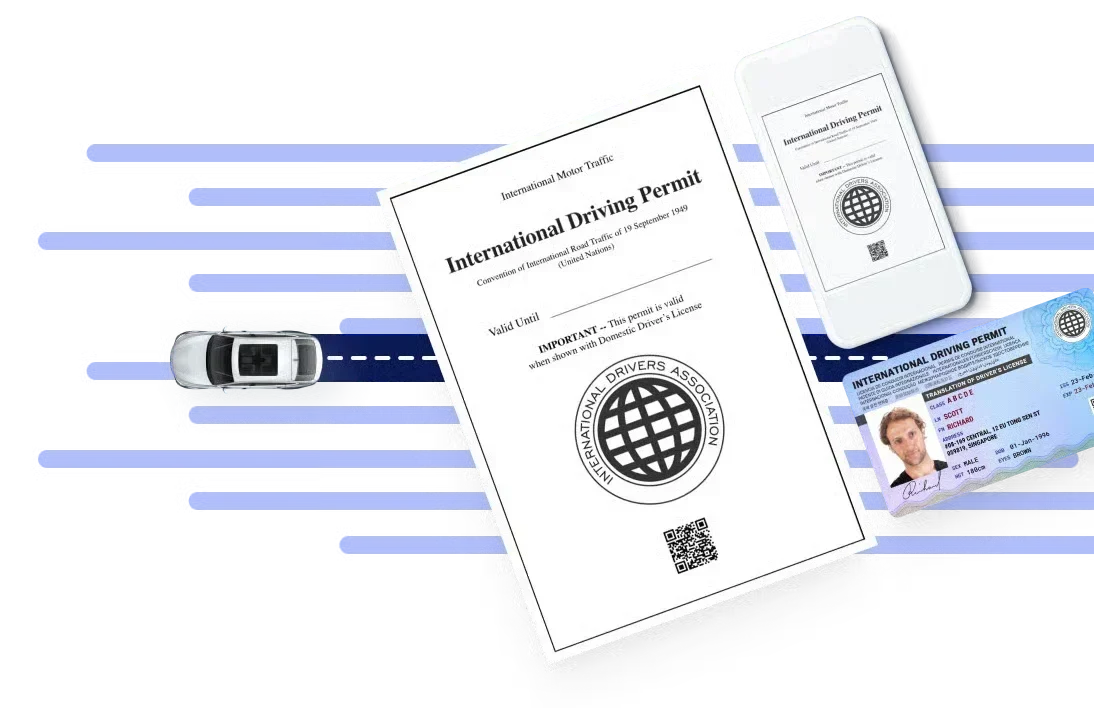Exploring Cambodia’s most beautiful temples offers travelers a captivating journey through centuries of history and culture. From bustling Phnom Penh to the ancient marvels of Angkor Wat in Siem Reap, this itinerary promises a blend of awe-inspiring temple complexes and the country’s cultural gems. Whether you’re drawn to the temples of Angkor Wat or the tranquil shores of Cambodia’s coastal towns, a road trip is undoubtedly the best way to uncover the diverse tapestry of Southeast Asia’s cultural and historical wonders.
Check if you need an IDP NowWhere was your license issued?
Destination
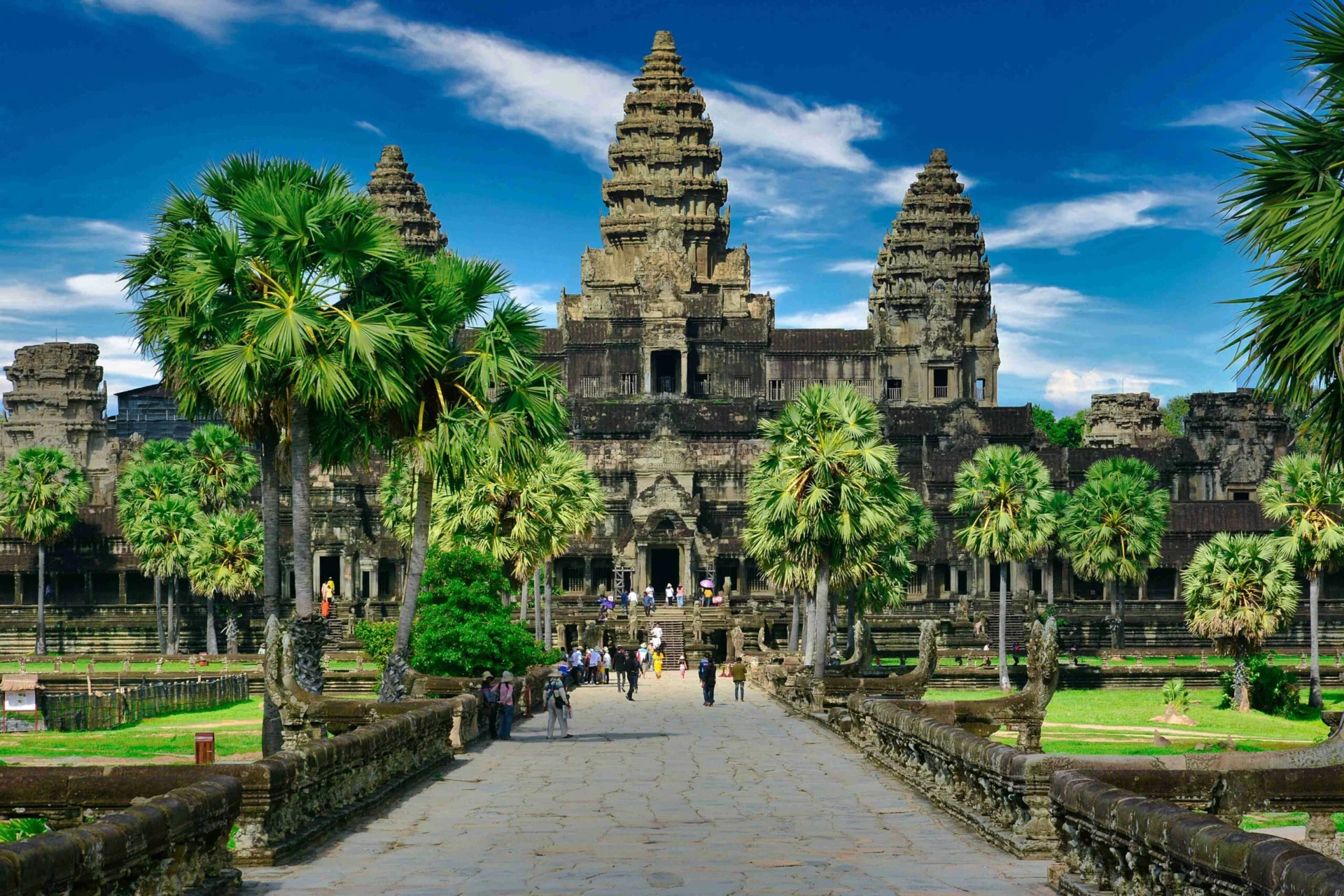
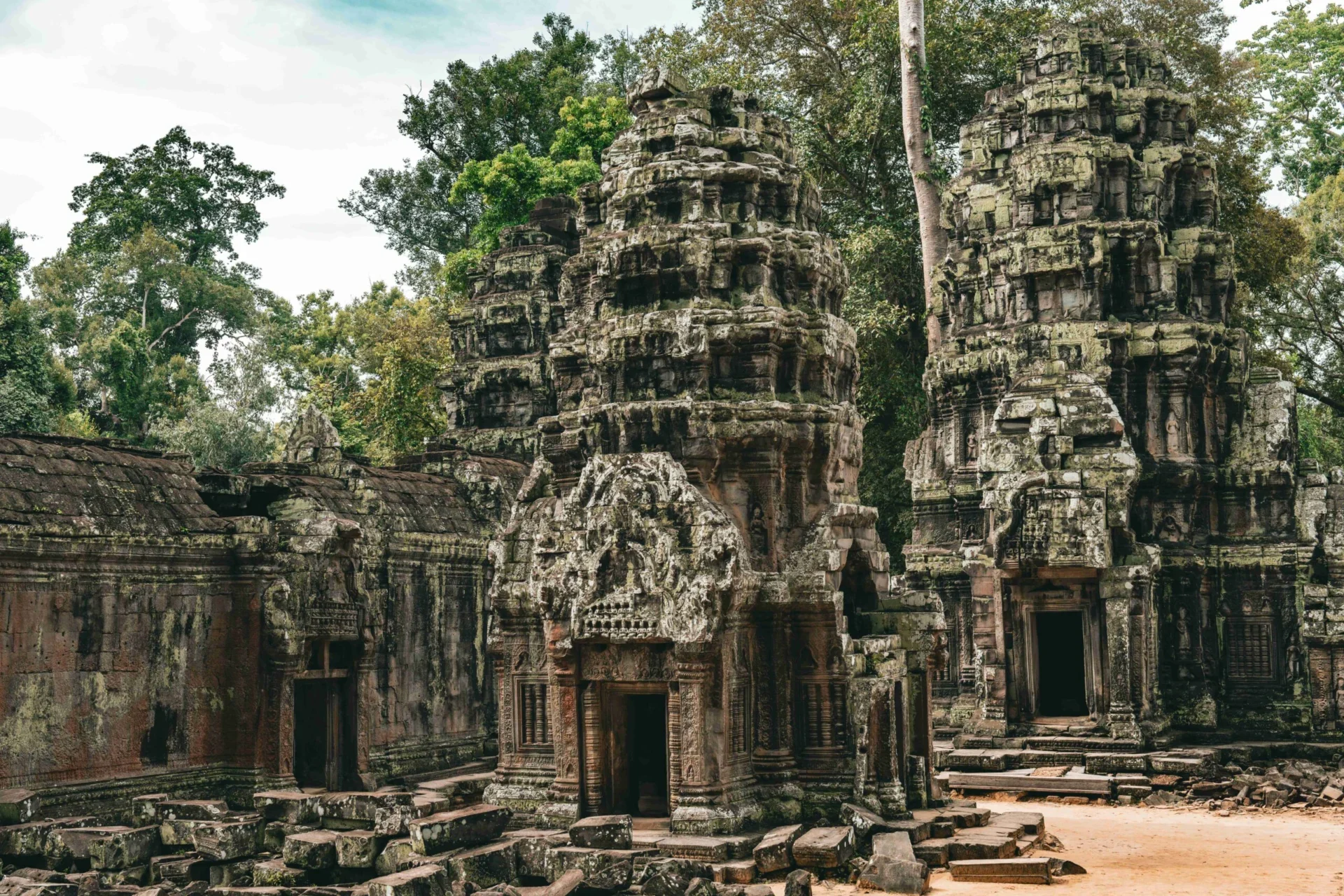
Temples of Angkor Wat Unveiled: A Perfect Day Trip Itinerary
Angkor Wat, situated in Siem Reap, Cambodia, stands as a testament to the architectural brilliance of the Khmer Empire during the early 12th century. Commissioned by King Suryavarman II, this majestic temple complex was originally dedicated to the Hindu god Vishnu before later being converted into a Buddhist site. As Cambodia’s most iconic landmark and a UNESCO World Heritage site, Angkor Wat draws visitors from around the globe, forming a pivotal part of any Southeast Asia itinerary.
How to Get There from Phnom Penh
To drive from Phnom Penh to Angkor Wat, take National Road 6 (NR6) northwest towards Siem Reap. This main highway covers about 320 kilometers and usually takes 5-6 hours, depending on traffic. NR6 is well-maintained, with rest stops and eateries along the way. Once near Siem Reap, follow signs to Angkor Wat, which is just north of the city.
Where to Go and What to Do
- Explore the Temples: Start with Angkor Wat itself, the largest and most iconic temple in the complex, known for its grandeur and intricate carvings.
2. Visit Angkor Thom: Explore the ancient city and its impressive Bayon Temple, famous for its stone faces and detailed bas-reliefs.
3. Take a Guided Tour: Engage a local guide to learn about the history, symbolism, and legends behind each temple, enhancing your understanding and appreciation of the site.
4. Climb Temples: Climb to the top of some temples, like Phnom Bakheng, for panoramic views of the entire temple complex and surrounding jungle.
5. Explore Lesser-known Temples: Venture beyond the main sites to discover lesser-known temples and ruins scattered throughout the Angkor Archaeological Park.
6. Attend Cultural Performances: In the evening, enjoy traditional Cambodian dance performances or cultural shows that often take place in Siem Reap.
7. Relax and Reflect: Take time to sit and absorb the spiritual and historical significance of Angkor Wat and its surroundings, appreciating its role in Cambodian history and culture.
Accommodations
In the area around and near Angkor Wat, there are luxury resorts, boutique hotels, guesthouses, and hostels. There are eco-friendly lodges, homestays, and luxury tented camps that offer a unique stay close to nature. Consider what amenities you need and read reviews to find the best place for your stay near Angkor Wat.
Did You Know?
- Temple: The Angkor Wat is the largest religious monument in the world, covering an area of over 162 hectares (400 acres)
- Treat: Fish Amok, a popular Cambodian dish, is traditionally steamed in banana leaves, which imparts a subtle, aromatic flavor to the dish.
Ta Prohm Unveiled: A Cambodia Road Trip Experience
Ta Prohm is a captivating temple located within the Angkor Archaeological Park near Siem Reap, Cambodia. Built-in the late 12th and early 13th centuries by King Jayavarman VII, Ta Prohm is renowned for its unique blend of ancient stone architecture and the intertwining roots of massive fig and silk-cotton trees. This symbiotic relationship between nature and man-made structures has made Ta Prohm a favorite among visitors, offering a glimpse into the mysterious allure of Angkor’s lost temples.
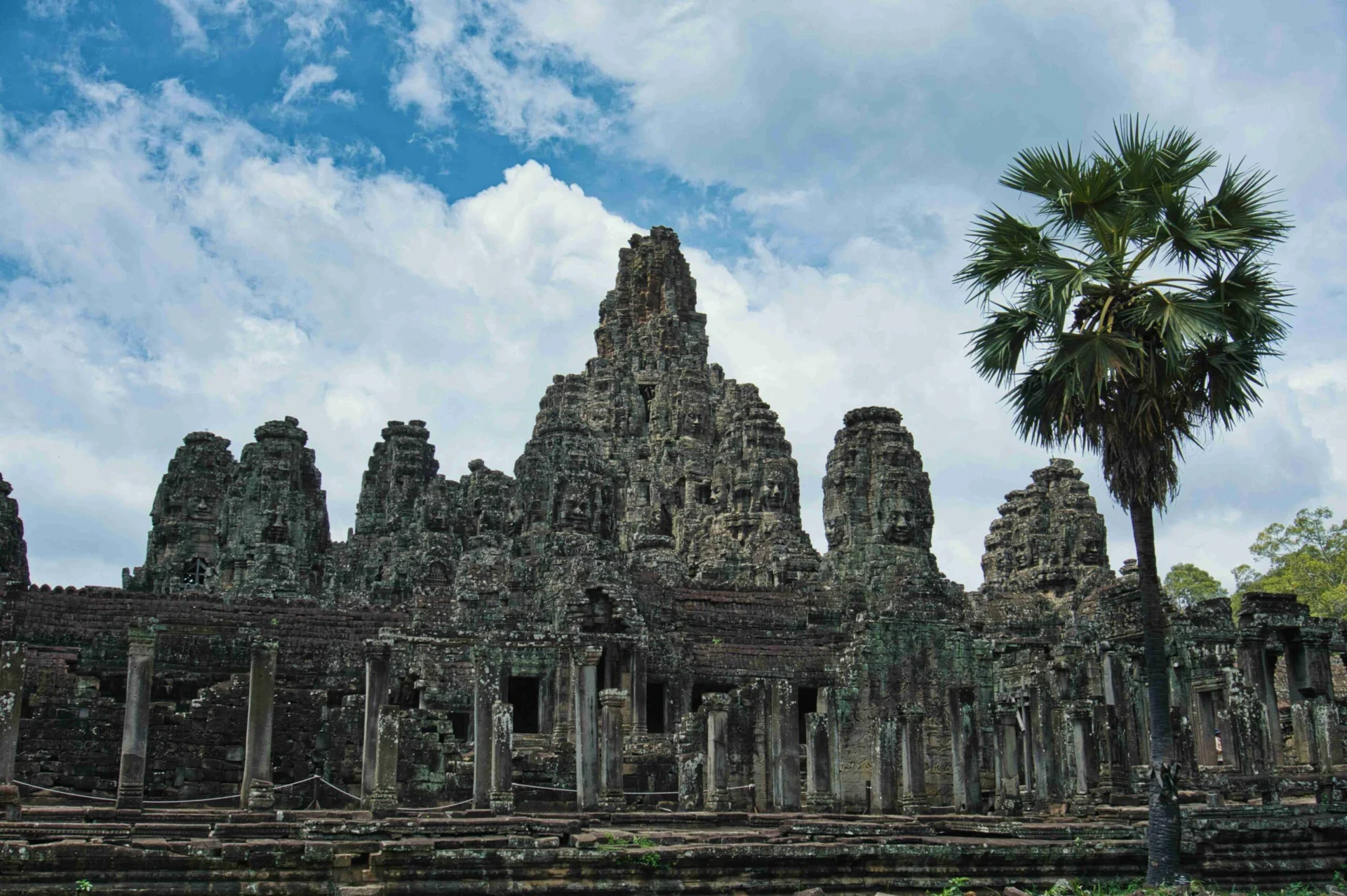
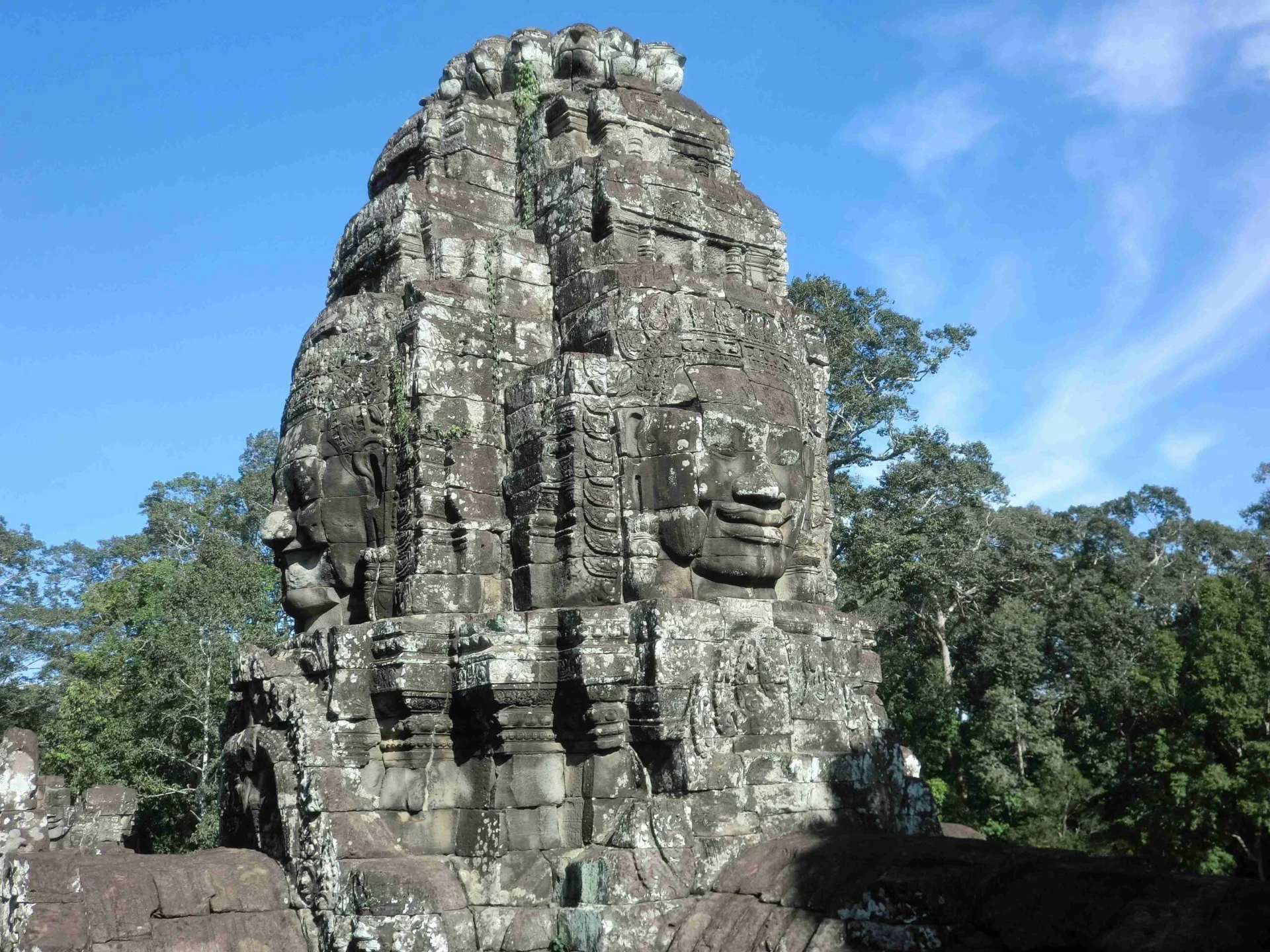
How to Get There from Phnom Penh
Head northwest on National Highway 6 (NH6), the main road linking Phnom Penh to Siem Reap. Covering approximately 315 kilometers (196 miles), the drive typically spans 5-6 hours, contingent upon traffic and road conditions. Follow NH6 through towns like Kampong Thom en route to Siem Reap. Upon arrival in Siem Reap, proceed towards the Angkor Archaeological Park or Angkor Wat, and then head northeast from Siem Reap city center for about 7 kilometers (4 miles) to reach Ta Prohm.
Where to Go and What to Do
Ta Prohm, located within the Angkor Archaeological Park in Cambodia, is renowned for its mystical and atmospheric ruins intertwined with massive trees and jungle growth. Here are five notable spots to explore within Ta Prohm:
- Central Sanctuary: The heart of Ta Prohm features a towering central sanctuary with intricate carvings and bas-reliefs depicting scenes from Khmer mythology and history.
2. Galleries and Cloisters: Surrounding the central sanctuary are galleries and cloisters with corridors with detailed stone carvings and sculptures, showcasing the architectural grandeur of the Khmer Empire.
3. Giant Spung Trees: One of the most iconic features of Ta Prohm is the integration of towering silk-cotton and strangler fig trees that have enveloped the temple ruins over centuries, creating a surreal and photogenic sight.
4. Lion Temple Gateways: Ta Prohm has impressive temple gateways featuring elaborate carvings of lions and other mythical creatures, offering glimpses into the past glory of the Khmer civilization.
5. Eastern Gopura: The eastern entrance of Ta Prohm, known as the gopura, is particularly notable for its well-preserved architecture and intricate stone carvings, providing insights into the temple’s historical and religious significance.
Accommodations
Staying in Siem Reap city center provides convenient access to a wide range of hotels, restaurants, and nightlife options, just a short distance from Ta Prohm. Whether you prefer luxury, boutique charm, budget-friendly lodging, or urban convenience, there are accommodations near Ta Prohm and throughout Siem Reap to meet every traveler’s needs.
Did You Know?
Temple: Ta Prohm was famously featured in the 2001 movie “Lara Croft: Tomb Raider,” starring Angelina Jolie.
Treat: Khmer Red Curry is traditionally served with bread, a culinary influence from the French colonial period in Cambodia.
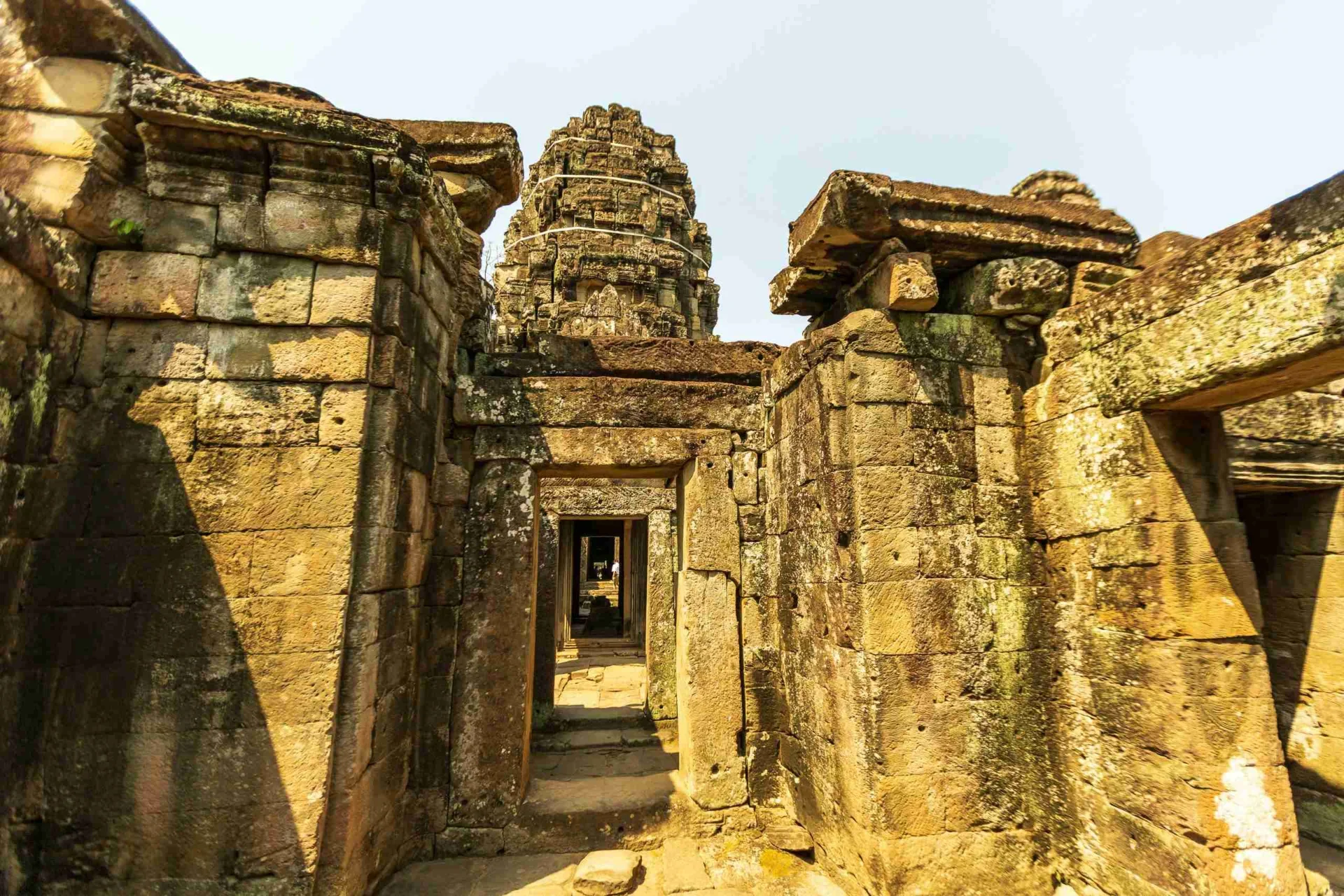
Travel Guide to Bayon Temple and the Stone Faces
Bayon Temple, located in the ancient city of Angkor Thom, is a must-see on any trip to Cambodia. Constructed in the late 12th to early 13th century by King Jayavarman VII, it is renowned for its 54 towers adorned with over 200 massive stone faces, each bearing a serene and enigmatic smile. These faces are believed to represent either the king himself or the bodhisattva of compassion, Avalokiteshvara.
How to Get There from Phnom Penh
To get to Bayon Temple from Phnom Penh by private car, head northwest on National Road 6, which connects Phnom Penh to Siem Reap. The drive covers about 320 kilometers and takes around 5-6 hours.
Where to Go and What to Do
- Photography: Capture the beauty of Bayon Temple through photography. The intricate carvings, serene stone faces, and the play of light and shadow offer excellent photo opportunities, especially during sunrise and sunset.
2. Exploring Bas-Reliefs: Study the detailed bas-reliefs that depict historical events, everyday life during the Angkor period, and mythological scenes. The bas-reliefs provide a narrative of the era’s cultural and social aspects.
3. Climbing the Central Towers: Climb to the upper levels of the temple to get a closer look at the iconic stone faces and enjoy panoramic views of the surrounding Angkor Thom complex.
4. Meditation and Reflection: Find a quiet spot within the temple grounds for meditation or reflection. The serene environment of Bayon Temple offers a peaceful setting for personal contemplation.
Accommodations
For budget travelers, there are homestays and hostels near the temple, especially if you prefer to immerse yourselves in Cambodian culture. Make sure to book or make arrangements ahead to avoid hassles especially during the peak seasons.
Did You Know?
Temple: Bayon Temple was originally built as a state temple and later converted to a Buddhist temple, reflecting the transition of Cambodia from Hinduism to Buddhism during the Khmer Empire’s reign.
Treat: The Cambodian dish Lok Lak translates to “shaking meat” in Khmer. It refers to the method of cooking the meat, which involves shaking or tossing it in a hot pan to sear it quickly while keeping it tender and juicy inside.
Cambodia Travel Guide to Preah Vihear Temple
This temple is renowned for its spectacular cliff-top setting and intricate Khmer architecture. The temple complex was dedicated to the Hindu god Shiva and was later adapted to Buddhism. It sits atop the Dangrek Mountains, which provide stunning panoramic views of the Cambodian plains below. Preah Vihear was recognized as a UNESCO World Heritage site in 2008.
How to Get There from Phnom Penh
Head north on National Road 6 towards Siem Reap and follow this road for about 320 kilometers until you reach Tbeng Meanchey town in Preah Vihear Province. Follow the signs and local directions, which may involve navigating smaller roads and asking locals for guidance. It takes around 6 to 7 hours to get there.
Where to Go and What to Do
Aside from the usual photography and cultural immersion, you may also want to check out nearby areas from the temple:
- Koh Ker: Known for its ancient Khmer ruins and the pyramid-like Prasat Thom temple.
Where was your license issued?
Destination
2. Sra’aem: A district with rural Cambodian charm and opportunities for exploring local culture.
3. Anlong Veng: Historically significant as the last stronghold of the Khmer Rouge, with sites like Pol Pot’s house and the Dangrek Mountains.
4. Chong Arn Ma: A village near the Thai-Cambodian border known for its picturesque landscapes and the Chong Arn Ma Market.
Accommodations
There are usual homestays, inns, and hotels a few minutes away from the temple, which feature the usual amenities for solo or group travelers.
Did You Know?
Temple: Preah Vihear Temple is notable for its unique architectural style that combines elements of both Khmer and Thai design, reflecting its historical and cultural significance between the two regions.
Treat: Bai Sach Chrouk is a popular breakfast dish in Cambodia consisting of grilled pork served over rice with pickled vegetables and a fried egg.
Majestic Heights: Phnom Bakheng Temple Road Trip Adventure
This hill temple is located in the Angkor Archaeological Park near Siem Reap, Cambodia. Built-in the late 9th century during the reign of King Yasovarman I, it is one of the earliest temples in the area and served as the state temple of Yasovarman’s capital city, Yasodharapura. The temple is renowned for its strategic hilltop location, offering panoramic sunset views of the nearby Angkor Wat temple complex.
How to Get There from Phnom Penh
To get to Phnom Bakheng via private car, start from Siem Reap city center and head towards the Angkor Archaeological Park entrance. From there, follow the signs leading to Phnom Bakheng. The distance is short, about 10 kilometers, and takes around 20-30 minutes, depending on traffic.
Where to Go and What to Do
- Historical and Cultural Learning: Engage with local guides or read informational plaques to learn about the history, culture, and religious significance of Phnom Bakheng.
2. Nature Walks: Enjoy the natural surroundings and perhaps spot local wildlife in the surrounding jungle areas.
3. Sunset Viewing: Come to Phnom Bakheng in the late afternoon to witness the sun setting over Angkor Wat.
4. Picnicking: Bring snacks or have a picnic while enjoying the views from the temple grounds.
Accommodations
It is recommended to stay in Siem Reap because the options are plenty from luxury hotels to resorts and guesthouses. When planning your stay near Phnom Bakheng, consider factors such as proximity to the temple, transportation options, and the type of experience you’re looking for.
Did You Know?
Temple: It is said that Phnom Bakheng inspired the design of Angkor Wat itself, including its five-tiered pyramid structure.
Treat: Nom Banh Chok is not just a popular dish for breakfast in Cambodia but is also traditionally associated with certain rituals and ceremonies, such as religious offerings and community gatherings. It’s a rice noodle dish topped with a fish-based green curry sauce and fresh herbs, often served with raw vegetables.
Sacred Ruins: Road Trip to Koh Ker Temple
Located in northern Cambodia, Koh Ker was briefly the capital of the Khmer Empire during the 10th century AD under King Jayavarman IV. This site features unique temple structures, including the imposing pyramid-shaped Prasat Thom, which stands as a testament to the architectural and artistic achievements of the Khmer civilization.
How to Get There from Phnom Penh
To reach Koh Ker from Phnom Penh via private car, follow National Road 6 northeast towards Siem Reap. After approximately 118 kilometers, turn left onto National Road 64, which leads directly to Koh Ker. The journey takes about 3-4 hours.
Where to Go and What to Do
- Visit Prasat Thom: Explore the pyramid-shaped temple, Prasat Thom, which stands as the central feature of Koh Ker. Climb to the top for panoramic views of the surrounding jungle.
2. Discover Prasat Krahom: Visit the Red Temple, known for its striking red bricks and intricate carvings, offering insights into ancient Khmer architecture.
3. Explore Prasat Bram: See the impressive 23-meter tall sandstone tower, Prasat Bram, which is adorned with detailed carvings and bas-reliefs depicting Hindu mythology.
Accommodations
Finding accommodations near Koh Ker can be challenging as the area is more remote and less developed compared to major tourist destinations in Cambodia. However, there are a few options available:
- Homestays and Guesthouses: Some local families offer basic accommodations in guesthouses or homestays, providing an opportunity for a more authentic experience.
2. Preah Vihear Boutique Hotel: Located about 50 kilometers from Koh Ker, this hotel offers comfortable rooms and basic amenities suitable for travelers exploring the region.
3. Siem Reap: While not near Koh Ker, Siem Reap offers a wider range of accommodations and is a common base for exploring both Angkor Wat and more remote sites like Koh Ker. It’s approximately 120 kilometers from Koh Ker.
4. Camping: For adventurous travelers, camping near Koh Ker can be an option, although facilities may be minimal. Ensure to arrange permits and necessary equipment in advance.
Did You Know?
Temple: Koh Ker boasts one of the largest pyramid temples in Cambodia, known as Prasat Thom which stands over 30 meters high with a seven-tiered pyramid structure.
Treat: Kuy Teav is often considered a comfort food in Cambodia, enjoyed by people of all ages throughout the day. It’s a Cambodian noodle soup with a clear broth, rice noodles, and usually beef or pork, garnished with fresh herbs and bean sprouts.
Tips on Planning a Trip to Cambodia
- Vehicle Rental: Rent a reliable vehicle suitable for Cambodian road conditions. Ensure it’s well-maintained and comes with insurance coverage. Popular options include SUVs or 4WDs for more remote areas.
- Driving Conditions: Be prepared for diverse road conditions. While major highways are generally well-maintained, rural roads can be rough. Drive cautiously, especially during the rainy season when roads can become muddy.
- Travel Documents: Ensure you have a valid driver’s license from your home country and an International Driving Permit (IDP). Keep your passport, visa, and vehicle registration documents handy.
- Local Cuisine: Explore Cambodian cuisine along your route. Try local specialties like Amok (fish curry), Kuy Teav (noodle soup), and fresh seafood in coastal towns.
- Cultural Etiquette: Respect local customs and traditions. Dress modestly, especially when visiting temples and rural areas. Learn basic Khmer phrases to communicate with locals.
🚗 Already in Cambodia and need an Overseas Driver’s Permit to drive? Get it online in 8 minutes! Valid worldwide. 24/7 support.
FAQs
When is the best time to visit Cambodia?The best time to visit Cambodia is during the dry season, from November to April when the weather is cooler and less humid; ideal for exploring cities like Phnom Penh and Siem Reap and visiting the Temples of Angkor Wat.
Do I need travel insurance for my trip to Cambodia?Yes, it’s highly recommended to have travel insurance that covers medical emergencies, trip cancellations, and theft. This ensures peace of mind while exploring Cambodia’s diverse landscapes and cultural sites.
Is it safe to drive in Cambodia?Driving in Cambodia can be challenging due to varying road conditions and local driving habits. Exercise caution, especially in urban areas where traffic can be congested, and be mindful of pedestrians and cyclists on the roads.
Do I need car insurance for my road trip in Cambodia?Yes, having car insurance is essential when driving in Cambodia. Ensure your insurance covers both third-party liability and damage to your vehicle, as this will provide peace of mind during your travels.
Should I get an International Driving Permit (IDP) to drive in Cambodia?Yes, it’s recommended to obtain an IDP along with your valid driver’s license from your home country. This permit is generally recognized in Cambodia and can be beneficial in case you need to communicate with local authorities. Click here to get your IDP faster.
Where can I find parking facilities in major cities like Phnom Penh and Siem Reap?Major cities in Cambodia offer both street parking and paid parking lots. In Phnom Penh and Siem Reap, hotels, shopping centers, and tourist attractions usually provide parking spaces. It’s advisable to use secure parking facilities, especially in busy areas, to safeguard your vehicle.
Wrapping It Up
Exploring Cambodia through a road trip lets you discover its rich history and diverse culture at your own pace. Traveling by road allows flexibility in your itinerary, whether you’re planning a week-long adventure or a quick day trip. It’s the ultimate way to experience Cambodia beyond the typical tourist spots, creating a memorable journey filled with discovery and adventure.
These routes are great for adventurous travelers who like exploring history and nature at their own pace, for those who enjoy flexible schedules and want to discover Cambodia’s ancient temples and diverse landscapes, and for people who love taking photos and trying local food while traveling independently.

